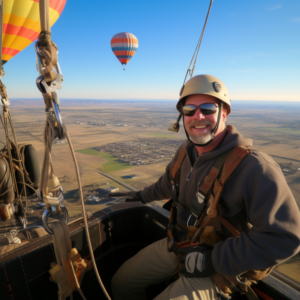Welcome to our special hot air balloon blog, where we prioritize safety above all else. In this article, we will delve into the crucial importance of safety in hot air ballooning and provide essential information and procedures for a smooth and secure flight. As experienced balloon pilots, we understand the significance of adhering to safety protocols to ensure the well-being of both passengers and crew. Join us as we explore the vital aspects of hot air balloon safety, empowering you with knowledge and confidence for a safe and enjoyable ballooning experience.
Section 1: Pre-Flight Preparations
Safety in hot air ballooning begins with thorough pre-flight preparations. We will discuss the importance of checking weather conditions, analyzing wind patterns, and assessing the suitability of the launch site. Detailed inspections of the balloon and equipment, including burners, fuel systems, envelopes, and baskets, are essential to identify any potential issues before takeoff. By meticulously preparing for the flight, pilots can mitigate risks and ensure a safe and smooth journey.
Section 2: Essential Safety Equipment
Hot air balloons are equipped with various safety devices to enhance passenger and crew well-being. We will cover essential safety equipment, including fire extinguishers, first aid kits, radios, and emergency instruments. Each item serves a specific purpose in ensuring a rapid response to any unforeseen circumstances. Additionally, we will emphasize the importance of proper training and regular maintenance of safety equipment to guarantee its effectiveness during critical situations.
Section 3: Passenger Briefing and Safety Guidelines
Passenger safety is paramount during hot air balloon flights. Pilots must conduct comprehensive passenger briefings to educate and prepare them for the journey. We will outline the safety guidelines, including proper boarding and exiting procedures, instructions for emergency landings, and guidelines for maintaining balance and stability during flight. Empowering passengers with knowledge and ensuring their understanding of safety protocols fosters a safe and enjoyable experience for all.
Section 4: Flight Operations and Communication
Safe flight operations and effective communication play a vital role in hot air ballooning. We will discuss the importance of clear and concise communication between the pilot and the crew, emphasizing the use of hand signals and radio communication. Furthermore, we will explore how continuous monitoring of weather conditions and airspace awareness contribute to safe navigation. By maintaining situational awareness and fostering effective communication, pilots can respond promptly to changing circumstances and ensure a secure flight.
Section 5: Emergency Procedures and Contingency Plans
Even with meticulous preparations, it is essential to be prepared for emergencies and unexpected scenarios. We will outline emergency procedures, including rapid descent techniques, emergency landings, and handling equipment malfunctions. Additionally, we will emphasize the significance of developing and implementing contingency plans to address unforeseen circumstances such as changing weather conditions or unexpected route deviations. Being prepared for emergencies enhances safety and instills confidence in both the pilot and passengers.
Safety is the foundation of hot air ballooning, and prioritizing it ensures a smooth and enjoyable experience for all. By adhering to rigorous pre-flight preparations, utilizing essential safety equipment, educating passengers, maintaining effective communication, and being prepared for emergencies, pilots can mitigate risks and ensure a secure journey. As you embark on your hot air balloon adventure, remember that safety is the cornerstone of every successful flight. So, entrust yourself to the hands of experienced and safety-conscious pilots, and enjoy the awe-inspiring beauty of the skies with peace of mind.



